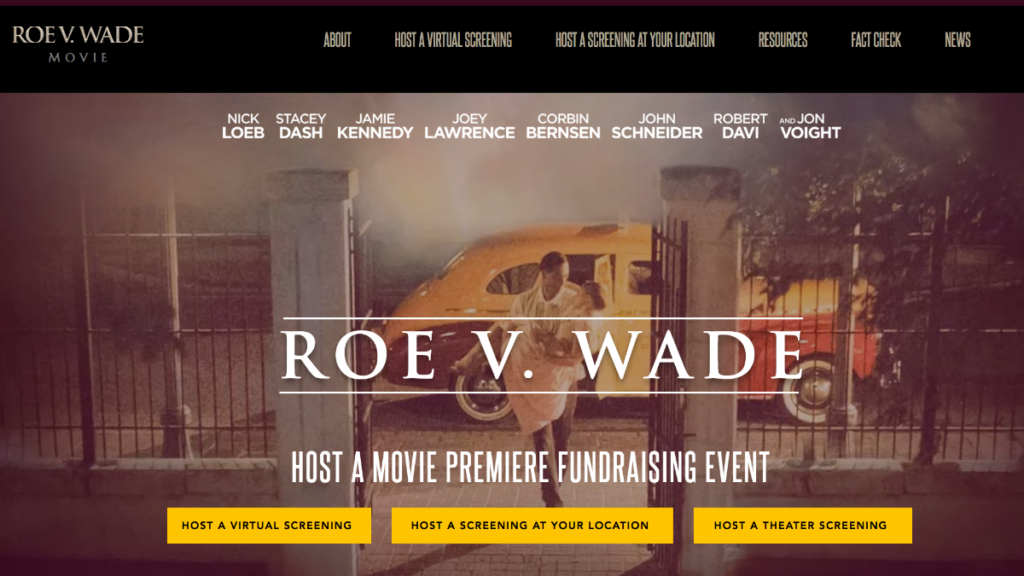Last updated on April 6th, 2021 at 02:52 pm
The end of February in the United States saw the premiere of Roe v. Wade, a film based on the facts concerning one of the most controversial court cases in American judicial history, which to this very day rather sharply divides the people of America, as well as the rest of the world.
Roe v. Wade is an “untold story of how people lied, how the media lied, and how the courts were manipulated” to legalize abortion across the United States. The decision which was rendered in 1973, has so far taken more than 60 million American lives, said Nick Loeb, the film’s co-director and co-producer. Loeb also plays the role of abortionist Dr. Bernard Nathanson. The film documents Nathanson’s journey when, after the discovery of the ultrasound, he was able for the first time to see how a baby behaved during an abortion. Nathanson would subsequently become an ardent opponent of the procedure.
The film was shot in secret and under a false title in order to avoid media backlash. Despite all the precautions, some actors and members of the film crew – including the original director – left the project when they realized that it was a pro-life film. Also, as was the case with the movie Unplanned, Facebook banned advertising for the film, as well as the film promotions for the crowdfunding site. It is therefore clear that Roe v. Wade remains one of the most controversial decisions in the history of the American judiciary.
The film covers the events in the United States from the 1960s, through the court case which ended in January 1973, and up to the year 1985 – beginning and ending with the testimony of Dr. Nathanson, who is also the narrator in the film. After his fiancée had a back-alley abortion, Nathanson (who passed away in February 2011) decided to dedicate himself to “saving women”, and in one decade was responsible for 60,000 abortions. He personally performed about 5,000 in his own private clinic; aborting even his own child.
But the real “father of the abortion movement” was Larry Lader, who was mentored by Margaret Sanger, a eugenicist and the founder of Planned Parenthood which is the largest provider of “abortion services” in the United States today. He recruited Nathanson and feminist Betty Friedan to start the first American organization for the legalization of abortion – the National Association for the Repeal of Abortion Laws (NARAL).
In the film, we see Lader finding the “right girl” – pregnant with an unwanted child, in a poor financial situation and with a troublesome history – in order to launch a court case that would demonstrate that the legalization of abortion is necessary to help women in difficult situations. However, Norma McCorvey, alias Jane Roe, actually never had an abortion, because the court procedure lasted much longer than her pregnancy.
In the first scientific paper in Serbian covering this topic: Roe v. Wade – the social circumstances that led to the legalization of abortion in the United States, I provide a detailed analysis of this court case. I also include the social circumstances in the United States that led to the legalization of abortion, and the lies that were spread by the media as well as medical professionals such as Dr. Nathanson, who later admitted and recounted everything in detail in his book The Hand of God .
The film, coming to US theaters on April 2nd, has a great cast of Hollywood celebrities such as John Voight, Robert Davi, Stacey Dash, and Steve Guttenberg.
For decades, feminists have been trying to convince us that abortion is a “woman’s right” and a necessary step on the path to female emancipation and empowerment. However, that is not the truth. Firstly, nowhere in international law is there a “right to abortion”, and secondly, when women show that they can have a child and finish college or advance in their career at the same time, they provide the best proof that not only are they able to study and work just as well as any man, but that they can achieve even more than that – which is what every mother knows, because she juggles all of this on a daily basis.
As Dr. Nathanson stated in the documentary The Silent Scream (1984), we, as mankind, must find a better solution for women than abortion. Nobody deserves to be subjected to such violence – either innocent babies or women. No woman should have to live with damaging psychological and physical consequences of a decision that can never be undone.
